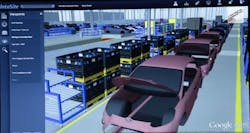Ford Uses Google Earth for Manufacturing Collaboration
One of the biggest issues confronting global manufacturers like Ford Motor Co. is the difficulty encountered when trying to share best practices across sites or foster communication between widely dispersed manufacturing centers. To help address this issue, Allison Stephens, technical leader for Ford Motor Co. ergonomics, approached Marty Smets, a Ford ergonomics engineer, with the idea of using Google Earth to solve the problem.
Stephens’ idea led Ford to work with Siemens’ product lifecycle management (PLM) software business unit, on the concept of providing virtual navigation within Ford’s assembly plants to help the company improve global collaboration and better share best practices. The resulting software, known as IntoSite, is a cloud-based web application in the Tecnomatix portfolio that was developed using the Google Earth infrastructure. IntoSite is a software-as-a-service (SaaS) application, with the software and the associated data hosted on the cloud and accessible via a web browser. According to Siemens, IntoSite holds 2D and 3D versions of Ford’s assembly plants and allows users to navigate virtually through the plants—down to the workstations—to obtain a better understanding of global processes.
At any virtual facility location, engineers or other team members can add pins to the 3D facility representations in IntoSite—just as they would in Google Maps—and upload content such as videos, documents and images to these pins.
Stephens says the rollout of IntoSite use at Ford began earlier this year at Ford’s Michigan Assembly Plant in Wayne, Mich., where the Ford Focus is built. The initial plan, according to Stephens, is to rollout IntoSite to all five global Focus production plants as the first major test of the software’s usefulness.
“With IntoSite, instead of sending a video or referencing something in an email, I can pin a specific spot on the virtual site—down to the 2D level of the entire plant—and input relevant info about a part or process. The information can be URL links, videos or even TeamCenter 3D CAD drawings. Workers can see a simulation of how to properly perform a job.”
The video at the bottom of this article provides an overview of how IntoSite works and how Ford is using it in the initial rollout.
As for security, Stephens notes that all access to IntoSite lies “behind Ford firewalls using the same IT protection applied to all other Ford IT systems. Any user has to be authorized to access the different systems connected to IntoSite, and each layer in the application is permissions based.”
Because the idea for the software was generated in the ergonomics department at Ford, it’s no surprise that much of the initial use of the IntoSite software has been by the ergonomics team.
“I use the software to look at a job before it becomes a job on the assembly line,” says Smets. “We look at all the components used on the car and how they go together so that workers can do their jobs safely. To do this, we capture motion of the vehicles we’re going to build a few years from now. We look at stress on operator.”
Smets says that technologies like IntoSite enable ergonomics studies to rapidly advance. “We used to look at things after an injury occurred. No we evaluate the job beforehand. We recognize we are morally obligated to make auto industry jobs safe and are designing jobs that can be performed by both males and females. We’re planning the manufacturing jobs of the future.”
According to Ford, the corporate goals for IntoSite are focused on three areas:
• Efficiency—IntoSite provides an opportunity to store and access documents pertaining to specific issues in a common place rather than have to access multiple internal systems. It also streamlines the process for sharing large media files, which often require access to a third-party file sharing program or the use of global shared drives with file size and storage duration limits.
• Globalization—Offering the ability to travel virtually to plants around the world, IntoSite helps to link together locations with real-world views in a shared online space.
• Standardization—A key part of the Ford production system, standardization is expected to improve as a result of IntoSite application’s file-sharing capabilities, which will help to resolve manufacturing issues, establish and share global common processes and resolve inconsistencies.

